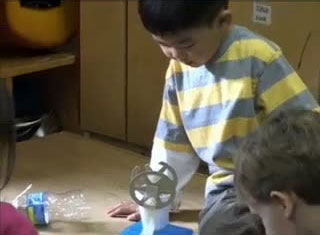About this video
This clip shows part of a “study group” meeting of four preschoolers and their teacher at University Primary School in Champaign, Illinois. University Primary School uses the Project Approach as part of its curriculum.
Along with another mixed-age classroom, the preschool class has been investigating ways to turn the school playground into an outdoor learning area. The four children shown here, and another child who is absent, are in the “Ramps and Slides” study group.
Before this meeting, this study group used a marble run to learn about how materials move on ramps and slides. Among other things, the children tried different ways to slow a marble’s movement from the top to the bottom of the run. Then, applying what they learned, they each drew plans (which they call designs) for additions to a water feature in the outdoor learning area. Finally, they selected materials from the school’s recycle room to make models based on their plans.
Preceding what is shown in this video clip, the children all described their models and how they thought the models would work while the teacher, Becca, held their designs up for all to see.
As this clip begins, Becca tells the visitor about a new idea that the children have had—combining a marble run with the water feature. Simon (4 years, 5 months) expands on Becca’s explanation by telling how he thinks the marble run could work.
The visitor restates what she has heard Simon say. Noah (4 years, 7 months) responds, “No” just as Simon says “Yeah.” Noah then presents a different perspective on the problem; he seems to feel that the pipe will have to contain water. Another child, Kaya (5 years, 1 month), breaks into Noah’s comments to assert that tape will be needed. Noah incorporates Kaya’s idea of using tape as he finishes his explanation.
Video
Transcript
Becca: Now they’re thinking of making some sort of marble run out of PVC pipes in the water—
Visitor: Oh—
Becca: —because then you could put the marbles through the water and they wouldn’t get wet.
Visitor: …in the marble—the marbles in the water, going through the pipes.
Becca: Yeah.
Noah: We didn’t have one.
Visitor: Cool.
Simon: (Gesturing to different parts as he talks.) Well, we could maybe, like, put the, like, I would say this was the pipe, and then we could put the marble through there, and then the water table’s there, and that’s the water, then we put the marble there, and it will go through there and into the water.
Visitor: Okay, so one way to do it is to have it go through a dry pipe into the water table.
Noah: No.
Simon: Yeah.
Noah: My idea says that we have to connect the thing that we have built toward the water table, to the water—can, can put—
Kaya: We have to tape that.
Noah: —we have to tape it. And we not connect it to the water table, that means that no water come in.
Visitor: If it’s not connected to the water table, no water will come in?
Noah: Mmm.
Benchmarks and How They Were Met
| Benchmarks | How They Were Met |
|---|---|
| Language Arts 1.A.ECc: Provide comments relevant to the context. | Simon and Noah added to their teacher’s description of the marble run idea for the visitor. Noah, Simon, and Kaya made additional comments about the structure and function of the marble run. |
| Language Arts 1.B.ECb: With teacher assistance, participate in collaborative conversations with diverse partners (e.g., peers and adults in both small and large groups) about age-appropriate topics and texts. | Noah and Simon spontaneously built upon the teacher’s description of the marble run to inform the visitor. They responded respectfully to comments from the visitor and from each other, even when their ideas diverged. Noah incorporated Kaya’s comment into his explanation. |
| Language Arts 1.B.ECc: Continue a conversation through two or more exchanges. | Both Simon and Noah contributed two or more comments to the discussion. |
| Mathematics 10.B.ECb: Make predictions about the outcome prior to collecting information, with teacher support and multiple experiences over time. | Simon speculated about how a marble might travel through a pipe into the water table. Noah offered a different prediction: If the pipe is not connected to the water table, “no water will come in.” |
| Science 11.A.ECb: Develop and use models to represent their ideas, observations, and explanations through approaches such as drawing, building, or modeling with clay. | All of the children brought the models they developed to the group meeting. Simon used parts of his model to explain an idea to the visitor. |
| Science 11.A.ECg: Generate explanations and communicate ideas and/or conclusions about their investigations. | Noah and Simon explained some of their ideas about a marble run to the visitor. Kaya added that they will have to tape the structure to the water table. |
| Science 12.E.ECa: Observe and describe characteristics of earth, water, and air. | Simon and Noah talked about ways to keep a marble from getting wet in the water table/marble run they would like to build. |
| Science 13.B.ECb: Become familiar with technological tools that can aid in scientific inquiry. | Simon and Noah used knowledge about pipes in their thinking about creating a marble run in a water table. Kaya and Noah used knowledge about uses of tape in their thinking about how to hold the marble run in place. |
| Social/emotional Development 31.A.ECe: Develop positive relationships with peers. | Simon and Noah conversed comfortably even though their ideas differed. Noah responded positively to Kaya’s suggestion about taping part of the structure. |


